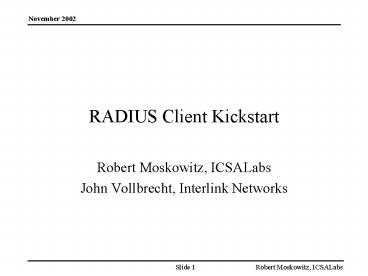RADIUS Client Kickstart - PowerPoint PPT Presentation
1 / 7
Title:
RADIUS Client Kickstart
Description:
IEEE 802.1X RADIUS Usage Guidelines ' ... Master Secret, using SNMPv2, between the device and RADIUS Server using a Diffie ... RADIUS used for the exchange ... – PowerPoint PPT presentation
Number of Views:36
Avg rating:3.0/5.0
Title: RADIUS Client Kickstart
1
RADIUS Client Kickstart
- Robert Moskowitz, ICSALabs
- John Vollbrecht, Interlink Networks
2
Houston, we have a problem
- IEEE 802.1X RADIUS Usage Guidelines
- IEEE Std 802.1X-2001 enables authenticated
access to IEEE 802 media, including Ethernet,
Token Ring, and IEEE 802.11 wireless LANs.
Although RADIUS support is optional within IEEE
Std 802.1X-2001, it is expected that most IEEE
Std 802.1X-2001 Authenticators will function as
RADIUS clients. - RFC 2865 Sec 3
- A RADIUS server MUST use the source IP address
of the RADIUS UDP packet to decide which shared
secret to use, so that RADIUS requests can be
proxied.
3
Stated Simply
- When an device that supports 802.1x
authentication is connected to the net it must be
configured with - the IP address or DNS name of its RADIUS server.
- It must also have a shared secret with the RADIUS
Server which is typically hand configured. - Finally, the device must be registered with the
DNS server, or assigned a permanent IP address. - This name or address must also configured in the
RADIUS Server.
4
What is wrong with this picture?
- Setting up the RADIUS Client shared secret
- The secret (password shared between the client
and the RADIUS server) SHOULD be at least as
large and unguessable as a well-chosen password.
It is preferred that the secret be at least 16
octets. This is to ensure a sufficiently large
range for the secret to provide protection
against exhaustive search attacks. The secret
MUST NOT be empty (length 0) since this would
allow packets to be trivially forged. - This is done manually on the RADIUS Client and
Server
5
More Wrongness
- The IP address of the AP MUST be fixed
- No DHCP, or use MAC controlled DHCP
- Same IP address always assigned to a given MAC
- Or devices DNS name available
- DYNDNS required?
- No mechanism to easily rekey MANY RADIUS Clients
- Only the single device with built-in EAP/RADIUS
will NOT be challenged
6
How to fix this
- Kickstart a Master Secret, using SNMPv2, between
the device and RADIUS Server using a
Diffie-Hellman exchange with Nonces. - Secret is bound to devices name, i.e. an APs
BSSID - S GET Client_Master_Public_DH-Value
- C SEND Client_Master_Public_DH-Value, Nonce
- S SET Server_Master_Public_DH-Value,
Server_IPSaddress, Nonce, HMAC-SHA1(Secret,
Server_IPSaddressNonce) - The Master secret is HMAC-SHA1(Kij,
Client_NonceServer_Nonce)
7
How to fix this
- Master Secret used to establish a the RADIUS
Client Secret bound to the devices IP address - RADIUS used for the exchange without RADIUS
authentication - This can also plumb other secrets, i.e. the
802.11f RADIUS keys - Master Secret Change using Diffie-Hellman with
nonces for Perfect Forward Secrecy - A Key Change forces a Boot Registration
8
Benefits
- No User configuration on Devices
- No user interface on Devices
- Manageability of RADIUS Client secrets
- Support for DHCP address assignment for Devices
9
Where will work get done
- IETF
- Individual(s) submission -- No RADIUS workgroup
- draft-ietf-moskowitz-RADIUS-Client-Kickstart-00.tx
t - Looking for community of interest
- Referenced by 802.1x Annex D

